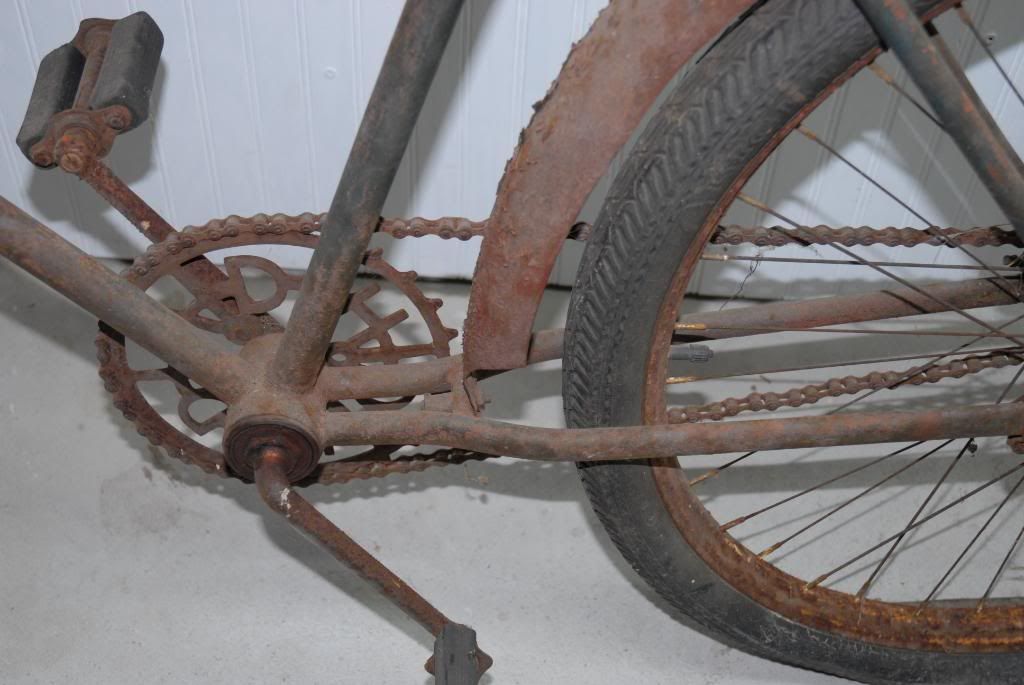"No matter what -- I'm extremely happy with what I've got here. It has beautiful lines and is elegant in its simplicity. As a motorcycle enthusiast, and a bicycle rider/enthusiast, this is a cross-over score for me. When I eventually restore its period components and cosmetic beauty, I'll place it where more folks can enjoy it as much as I do."
I understand what you are saying in this passage but I think from several of the posts in this thread that the ties this bike has or doesn’t have to the Harley Davidson company are important to how it is perceived and valued by many people.
I’ll also say again that I do not consider myself a Harley Davidson expert but what I do know about the 1917-1922 models leads me to believe that beyond the Chainring there may be no true connection to HD. I’m posting this as a bicycle historian so that if anyone is interested in studying further whether or not the bike is a Harley Davidson they can start with what I know.
First. You are correct; as I stated Harley Davidson branded bicycles from 1917 to 1922 were not made by Harley Davidson. To the best of my knowledge, they were all manufactured by the Davis Manufacturing Company, one of America’s largest bicycle manufacturing companies at that time. They were not made by Singer, an English firm.
While HD did not make the bicycles themselves, the bicycles that originally wore the HD badge became a Harley Davidson sanctioned product by the fact that the company purchased them from Davis and had them officially badged as Harley Davidsons for sale though their network of Motorcycle dealers.
The only bicycles from 1917-1922 that are true Harley Davidson bicycles are those bicycles that were
originally badged by the company and sold as such. A bicycle assembled today with an identical Davis frame and original components from an original Harley bicycle is a Replica rather than an actual, true Harley Davidson bicycle (making “Harley Davidson” bicycles from Davis frames and reproduction sprockets and head badges is very common in the hobby). One step further from representing a period Harley Davidson bicycle would be a bicycle built along the lines of a Harley Davidson bicycle but with a non-Davis frame and similar but not identical period components. A bicycle constructed as such is probably best referred to as a “Harley Tribute.” Needless to say, a 70’s Honda painted and badged to look like a 20’s Harley will fool some people and not others. A twenties Indian painted and badged to look like a twenties Harley will fool more people but it is still in no way a Harley.
There is nothing “wrong” with any of the above and all exist today in the hobby. The collector market value of each will relate to the provenance of the original Harley specification content. Obviously, there is a grey area which is the zone that counterfeit Harley forgers are aiming for and it behooves any buyer to know as much as possible to avoid being scammed.
Back to your bike.
You are confident that what you have is not an elaborate forgery and I am inclined to agree, as an elaborate forgery it would be more convincing. In all likelihood the seller’s father moved an HD sprocket and perhaps crank onto another frame, which was a common occurrence in the day. The HD Sprocket is cool now and was cool then and cool parts were often swapped out to replace more boring pieces. If the Sprocket and the crank were moved to the bike 50 or more years ago and the bike was used after that there is no reason that the modification would show as a major deconstruction.
The fenders and wheels are definitely not from a bicycle built any earlier than 1933 so it is impossible that they are correct for a 1917-1922 HD bicycle. Your wheels are obviously balloon tires on balloon rims (the tires will be marked 26x2.125 which is a size that was not available until 1933.)
The wheels and fenders are not a problem as that is a common swap to keep earlier 28” single tube bicycles operable after 28” wheel and tires became obsolete.
My main point and the main concern is the frame, it is either an original HD sanctioned frame or it is not. I tend to adhere to the belief that the true identity of any bike is the frame and the bike’s provenance follows that frame. Thus, if this frame is not one of the original frames made and badged for HD then the bike is not a Harley Davidson. If it is an identical frame to a Harley Davidson sanctioned frame (Davis Manufactured) then you have the beginnings of a potential Harley Davidson replica. If, as I believe the frame is not a Harley Frame or even a Davis frame then at best you have a potential start of a Harley Tribute bike built around an original crankset and sprocket.
In the end it doesn’t matter to me if the bike is a true Harley Davidson bicycle or not and it may not to you either. My knowledge of the subject leads me to believe the core bike is not one of the bicycles sanctioned by the company between 1917 and 1922 so I am only responding to note that my research does not back that claim.











































































